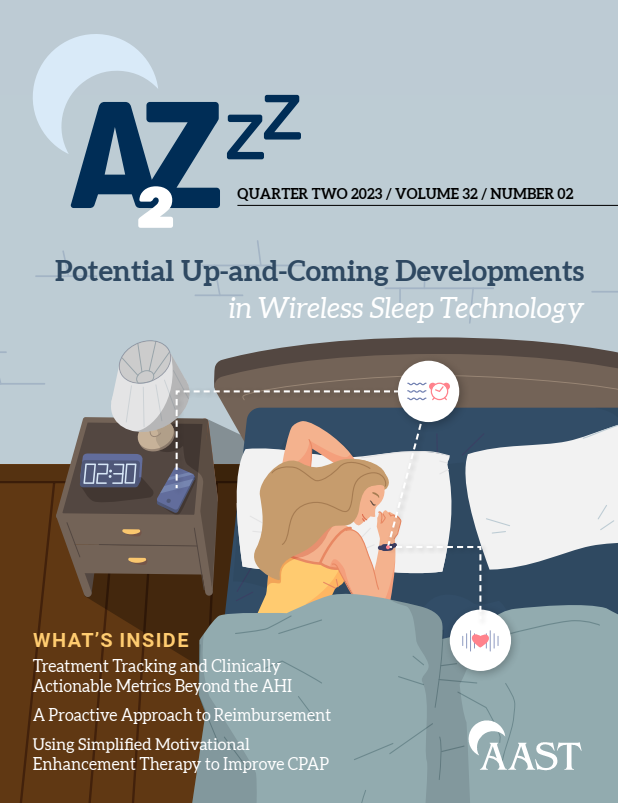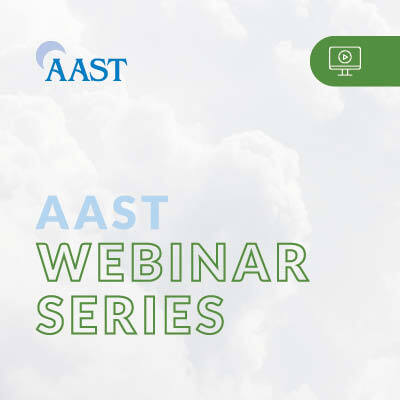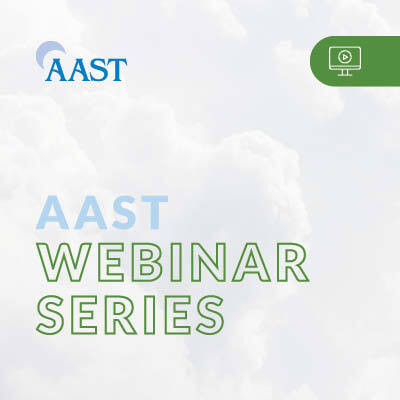
Recommended for You
- Includes Credits
This webinar will provide an overview of sleep health through the lens of behavioral sleep medicine - addressing the fundamental functions of sleep, sleep disorders, and treating insomnia and CPAP non-adherence using evidence-based methodologies.
This webinar will provide an overview of sleep health through the lens of behavioral sleep medicine - addressing the fundamental functions of sleep, sleep disorders, and treating insomnia and CPAP non-adherence using evidence-based methodologies.
Objectives:
1. Provide an overview of normal human sleep functioning
2. Identify and assess common sleep disorders
3. Fundamentals of behavioral interventions for insomnia and CPAP adherence.
Natalia S. David, PsyD, DBSM
Director of Training, DrLullaby.com
Continuing Education:
- 1 AAST CEC after passing a short knowledge assessment in the AAST Learning Center
Access:
- Free with AAST Membership
- $30 for Non-Members
-
Register
- Non-member - $30
- Member - Free!
- More Information
- Includes Credits
A2Zzz Q3 2023/ Volume 32/ Number 3
The 2023 Q3 issue of A2Zzz is here! This issue's cover story offers advice for sleep-care professionals treating sleep problems in patients with long COVID.
Explore additional articles, including:
- The Impact of Sound on Sleep
- Sleep Hygiene: Practicing What You Preach
- The Impact of Halloween on Sleep Hygiene
Updates to Claiming CECs From A2Zzz
AAST members looking to claim their free AAST continuing education credits (CECs) from reading the latest issue of A2Zzz will now need to complete a knowledge assessment in the Learning Center. Upon completion of the knowledge assessment, AAST members will be awarded their two free AAST CECs. For additional information on this change, please view the instructions for earning credits from A2Zzz.
-
Register
- Non-member - $30
- Member - $15
- More Information
- The Impact of Sound on Sleep
- Includes Credits
A2Zzz Q4 2023/ Volume 32/ Number 4
The 2023 Q4 issue of A2Zzz is here! The use of the Internet of things (IoT) in the sleep field is showing promise in improving the diagnosis and management of sleep disorders, primarily obstructive sleep apnea (OSA). But are the drawbacks of IoT enough to prevent it from being fully utilized by sleep professionals?
Explore additional articles, including:
- Revenge Bedtime Procrastination
- SPONSORED: Is the Apnea-hypopnea Index the Best Metric for Evaluating Obstructive Sleep Apnea
- Sleep Scoring Among Different Types of Scorers: Thoughts on Getting to 100% Agreement
Updates to Claiming CECs From A2Zzz
AAST members looking to claim their free AAST continuing education credits (CECs) from reading the latest issue of A2Zzz will now need to complete a knowledge assessment in the Learning Center. Upon completion of the knowledge assessment, AAST members will be awarded their two free AAST CECs. For additional information on this change, please view the instructions for earning credits from A2Zzz.
-
Register
- Non-member - $30
- Member - $15
- More Information
- Includes Credits
A variety of cases are used to review CPAP titration for OSA, beginning with patient interaction, mask fitting, and establishing a relationship for collection of outcomes. A simple flow chart for titration is presented and complexities are explored. Rules for identifying respiratory events and using events to determine PAP pressure increases are listed. The perils of over-titration are assessed and rules for down-titration are discussed. What does the technologist add to the titration process? A comparison of human and auto-titration methodologies provides the answer.
Description: A variety of cases are used to review CPAP titration for OSA, beginning with patient interaction, mask fitting, and establishing a relationship for collection of outcomes. A simple flow chart for titration is presented and complexities are explored. Rules for identifying respiratory events and using events to determine PAP pressure increases are listed. The perils of over-titration are assessed and rules for down-titration are discussed. What does the technologist add to the titration process? A comparison of human and auto-titration methodologies provides the answer.
Presenter: Richard S. Rosenberg, PhD
Recorded: 7/12/2017
CEC Credit(s): 1.0
Target Audience: Sleep technologists seeking a background in PAP titration for obstructive sleep apnea.
Length: 45 minutes
-
Register
- Non-member - $30
- Member - $15
- More Information
-
Register
- Includes Credits
A2Zzz Q2 2023/ Volume 32/ Number 2
The 2023 Q2 issue of A2Zzz is here! This issue's cover story examines the latest developments in wireless sleep technology being used to screen for obstructive sleep apnea (OSA).
Explore additional articles, including:
- Potential Up-and-Coming Developments in Wireless Sleep Technology
- Optimizing Patient Outcomes Requires More Than Single-Night Testing for Sleep Apnea
- A Proactive Approach to Reimbursement
- The Reluctant Patient: Simplified Motivational Enhancement Therapy to Improve CPAP Adherence
Updates to Claiming CECs From A2Zzz
AAST members looking to claim their free AAST continuing education credits (CECs) from reading the latest issue of A2Zzz will now need to complete a knowledge assessment in the Learning Center. Upon completion of the knowledge assessment, AAST members will be awarded their two free AAST CECs. For additional information on this change, please view the instructions for earning credits from A2Zzz.
-
Register
- Non-member - $30
- Member - $15
- More Information
- Includes Credits
A2Zzz Q1 2023/ Volume 32/ Number 1
The 2023 Q1 issue of A2Zzz is here! This issue's cover story examines the research surrounding home sleep testing devices for long-term follow-up of patients treated for obstructive sleep apnea.
Explore additional articles, including:
- Case Study: Implementing an Apprentice Program at the Sleep Lab
- Everything You Wanted to Know About the SDS Credential
- President's Message
- From AAST
Updates to Claiming CECs From A2Zzz
AAST members looking to claim their free AAST continuing education credits (CECs) from reading the latest issue of A2Zzz will now need to complete a knowledge assessment in the Learning Center. Upon completion of the knowledge assessment, AAST members will be awarded their two free AAST CECs. For additional information on this change, please view the instructions for earning credits from A2Zzz.
-
Register
- Non-member - $30
- Member - $15
- More Information
- Includes Credits
Panel of Senior Sleep Technologists sharing their experiences and lessons that have helped build their successful careers in the sleep center, sleep industry and sleep education.
A panel of senior sleep technologists will be sharing their experiences and lessons learned that have helped build their successful careers in the sleep center, and sleep industry.
Objectives:
1. Provide insight on what skillsets helped prepare for their current roles
2. Understand different roles in the sleep field
3. Discuss training not just for new employees, but ongoing to promote educational growth and promote career opportunitiesSpeakers:
- Sarah Brennecka, BA, RPSGT, AAST Education Advisory Committee Chair
- Bryan Beaudette, RPSGT, CCSH
- Tessa Klucznyk, RST, RPSGT
- Andrea Ramberg, RPSGT, CCSH
Continuing Education:
1 AAST CEC after passing a short knowledge assessment in the AAST Learning Center-
Register
- Non-member - $30
- Member - $15
- More Information
- Includes Credits
Obstructive Sleep Apnea (OSA) in children effects of 2-3% of all children, however in light of the rising prevalence of childhood obesity, the estimated prevalence has increased to 6-10% of all children. While the first line of therapy for Pediatric OSA in children consists of upper airway surgery via surgical removal off the adenoids and tonsils, it has become increasingly clear that surgery efficacy is limited in older and//or obese children. As a result, alternative therapies, including positive airway pressure (PAP) therapy has become mainstay for a lot of children. The application of PAP devices in children is unique and requires further attention to ensure that PAP therapy is successful.
Obstructive Sleep Apnea (OSA) in children effects of 2-3% of all children, however in light of the rising prevalence of childhood obesity, the estimated prevalence has increased to 6-10% of all children. While the first line of therapy for Pediatric OSA in children consists of upper airway surgery via surgical removal off the adenoids and tonsils, it has become increasingly clear that surgery efficacy is limited in older and//or obese children. As a result, alternative therapies, including positive airway pressure (PAP) therapy has become mainstay for a lot of children. The application of PAP devices in children is unique and requires further attention to ensure that PAP therapy is successful.
Objectives:
- Provide an overview of Obstructive Sleep Apnea in children
- Distinguish indications for Positive Airway Pressure (PAP) therapy in children
- Discuss obstacles of PAP adherence in children
- Share real world data of PAP adherence in children
Rakesh Bhattacharjee, MD, FRCPC, DABP(SM), CBSM, DBSM, FAASM
Director of Sleep Medicine, Rady Children’s Hospital
Associate Clinical Professor of Pediatrics, UCSD
Continuing Education:
- 1 AAST CEC after passing a short knowledge assessment in the AAST Learning Center
Access:
- Free with AAST Membership
- $30 for Non-Members
-
Register
- Non-member - $30
- Member - $15
- More Information
- Includes Credits
This pre-recorded web course discusses Central Sleep Apnea as well as the clinical evidence for phrenic nerve stimulation. This content is provided by Respicardia.
This content is provided by Zoll/Respicardia.

Join us for a pre-recorded web course discussing Central Sleep Apnea as well as the clinical evidence for phrenic nerve stimulation.
Topics include:- CSA pathophysiology and prevalence
- How phrenic nerve stimulation therapy works in stabilizing breathing
- Appropriate patients for phrenic nerve stimulation
- Clinical results at 6, 12 and 18 months
Presenters:
Dr. Alan Schwartz
- Professor of Medicine, ret. (Johns Hopkins School of Medicine)
- Clinical Associate Professor (University of Pennsylvania Perelman School of Medicine)
- Profesor Extraordinario Visitante (Universidad Peruana Cayetano Heredia, Lima PERU)
- Former medical director of the Johns Hopkins Sleep Disorders Center and co-director of the Johns Hopkins Center for Interdisciplinary Sleep Research and Education
Dr. Robin Germany
- Chief Medical Officer of Respicardia
- Clinical Assistant Professor, Division of Cardiovascular Disease, University of Oklahoma
CEC Credit(s): 1.0
Length: 52 minutes
-
Register
- Non-member - Free!
- Member - Free!
- More Information
- Includes Credits
This presentation discussed barriers to effective communication and techniques used to improve day to day patient interactions to influence outcomes. These topics expand to all patient areas, but it focuses on some sleep specific scenarios. This course is also available through the California Board of Registered Nursing, Provider License No. CEP17872 for 1 contact hour.
This presentation discussed barriers to effective communication and techniques used to improve day to day patient interactions to influence outcomes. These topics expand to all patient areas, but we will focus on some sleep specific scenarios.
Objectives:
- Recognize the impact of low health literacy on sleep health outcomes
- Describe methods of communication techniques to support patients' therapeutic journey and wellbeing
- Evaluate patient understanding of condition/treatment options
Speakers:
- Robyn Woidtke, MSN, RN, RPSGT, CCSH, FAAST
Continuing Education:
- 1 AAST CEC after passing a short knowledge assessment in the AAST Learning Center
- Provider approved by the California Board of Registered Nursing, Provider License No. CEP17872 for 1 contact hour.
-
Register
- Non-member - Free!
- Member - Free!
- More Information
| Access Date | Quiz Result | Score | Actions |
|---|

















